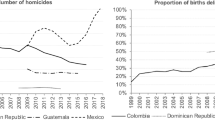Abstract
Investigations into the existence and impact of defensive medicine in obstetrics have produced mixed and often conflicting implications. The most widely-cited and accepted results in this literature find that less severe malpractice environments cause an increase in the use of cesarean section. This has been interpreted as “offensive medicine”; taking advantage of lenient malpractice environments by providing unnecessary services in order to raise revenue. In this article we show that an assumption concerning births with an unknown method of delivery, which is not explicitly stated in the literature, is pivotal in obtaining these results. Using data on tort reforms and birth outcomes from 1989 to 2001 in 24 US states, we show that for the 98.4% of births with a confirmed method of delivery, the estimated effects of tort reform on C-section rates are insignificant. Therefore, without this assumption, there is little evidence to support an interpretation of offensive medicine.
Similar content being viewed by others
Notes
The authors would like to thank Janet Currie and W. Bentley MacLeod for their assistance in conducting the replication of their study, as well as for their helpful suggestions and comments.
The average amounts of the noneconomic-damages caps and of the punitive-damages caps are excluded from the summary statistics because they are not included in the regressions. Matching CM’s sample means for these variables would require following their method for deflating and imputing the amounts, which was not attempted in this study.
The tort reform variables were generated according to the exact coding used in CM. The authors thank Janet Currie and W. Bentley MacLeod for making their code available.
Frakes (2012) also suggests the true effect is smaller than CM’s estimate.
Assuming that data was recorded correctly in all sample states during subsequent years, this specification should determine the impact of the institutional delay in data collection on CM’s parameter estimates. The results indicate that, besides the magnitude of coefficient estimates, the institutional delay does not appear to drive much of CM’s findings.
CM indicate that their results were robust to the systematic exclusion of large states, but based on the third column of Table 3, this does not hold for the replication sample.
References
Avraham, R., & Schanzenbach, M. (2015). The impact of tort reform on intensity of treatment: Evidence from heart patients. Journal of Health Economics, 39, 273–288.
Baldwin, L. M., Hart, L. G., Lloyd, M., Fordyce, M., & Rosenblatt, R. A. (1995). Defensive medicine and obstetrics. Journal of the American Medical Association, 274(20), 1606–1610.
Cano-Urbina, J., & Montanera, D. (2016). The differential effects of malpractice reform: Defensive medicine in obstetrics, Working Paper
Chen, B. K., & Yang, C. Y. (2014). Increased perception of malpractice liability and the practice of defensive medicine. Journal of Empirical Legal Studies, 11(3), 446–476.
Currie, J., & MacLeod, W. B. (2008). First do no harm? Tort reforms and birth outcomes. The Quarterly Journal of Economics, 123(2), 795–830.
Dubay, L., Kaestner, R., & Waidmann, T. (1999). The impact of malpractice fears on cesarean section rates. Journal of Health Economics, 18(4), 491–522.
Dubay, L., Kaestner, R., & Waidmann, T. (2001). Medical malpractice liability and its effect on prenatal care utilization and infant health. Journal of Health Economics, 20, 591–611.
Frakes, M. (2012). Defensive medicine and obstetric practices. Journal of Empirical Legal Studies, 9(3), 457–481.
Grant, D., & McInnes, M. M. (2004). Malpractice experience and the incidence of cesarean delivery: A physician-level longitudinal analysis. Inquiry, 41(2), 170–188.
Kessler, D., & McClellan, M. (1996). Do doctors practice defensive medicine? Quarterly Journal of Economics, 111(2), 353–390.
Kim, B. (2007). The impact of malpractice risk on the use of obstetrics procedures. The Journal of Legal Studies, 36(S2), S79–S119.
Lieber, E. M. J. (2014). Medical malpractice reform, the supply of physicians, and adverse selection. Journal of Law and Economics, 57(2), 501–527.
Localio, A. R., Lawthers, A. G., Bengston, J. M., Hebert, L. E., Weaver, S. L., Brennan, T. A., et al. (1993). Relationship between malpractice claims and cesarean delivery. Journal of the American Medical Association, 269(3), 366–373.
National Center for Health Statistics. (1992). Public use data tape documentation: 1989 detail natality. Center for Disease Control: Data description.
Shurtz, I. (2013). The impact of medical errors on physician behavior: Evidence from malpractice litigation. Journal of Health Economics, 32(2), 331–340.
Shurtz, I. (2014). Malpractice law, physicians financial incentives, and medical treatment: How do they interact? Journal of Law and Economics, 57(1), 1–29.
Tussing, A. D., & Wojtowycz, M. A. (1992). The cesarean decision in New York State, 1986: Economic and noneconomic aspects. Medical Care, 30(6), 529–540.
Yang, Y. T., Mello, M. M., Subramanian, S. V., & Studdert, D. M. (2009). Relationship between malpractice litigation pressure and rates of cesarean section and vaginal birth after cesarean section. Medical Care, 47(2), 234–242.
Author information
Authors and Affiliations
Corresponding author
Rights and permissions
About this article
Cite this article
Cano-Urbina, J., Montanera, D. Do tort reforms impact the incidence of birth by cesarean section? A reassessment. Int J Health Econ Manag. 17, 103–112 (2017). https://doi.org/10.1007/s10754-016-9202-8
Received:
Revised:
Accepted:
Published:
Issue Date:
DOI: https://doi.org/10.1007/s10754-016-9202-8




